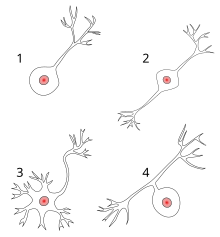Unipolar nerve cell

1 unipolar nerve cell
2 bipolar nerve cell
3 multipolar nerve cell
4 pseudounipolar nerve cell
A nerve cell (neuron) is called unipolar (also monopolar ) if it has only one extension ( axon ) and no extensions ( dendrites ).
description
Under the microscope, these nerve cells look like a golf ball on a large T. Their cell body is round to slightly oval and contains the cell nucleus in the center. Only a single nerve fiber arises from the cell body. In pseudounipolar cells, this process can be divided into two branches in a T-shape, one leading to the body periphery and registering sensory information (receptive), while the other forwards it to the central nervous system or the spinal cord . However , there are no synaptic contacts between the neurons of a sensory ganglion. Most of the time, unipolar neurons receive sensory events such as touch and temperature changes from the skin, joints, and muscles. This receptor process is located in the apical area of the cell body. An axon is sent out basally. Certain areas of the process serve as receptive surfaces, others for the release of transmitters. Typical unipolar cells are the photoreceptors of the retina ( cone cells and rod cells ), which represent the first neuron of the visual pathway there.
Occurrence


Unipolar cells are more typical of the invertebrate nervous system . But they also occur in vertebrates, including humans. In both vertebrates and invertebrates, many primarily sensory nerve cells are unipolar. These typically have a special structure in order to translate a physical stimulus (light, sound, temperature, etc.) into an electrical signal and to conduct this on to the brain or spinal cord . However, the independent occurrence in differentiated nerve tissue is also controversial and the view is also held that they only occur in vertebrates in the embryo during the histogenesis of the nerve cells.
Invertebrates
Unipolar neurons are often found in insects where the cell body is located on the periphery of the brain and is electrically inactive.
Vertebrates / human
Especially in sensory ganglia . They are found in particular as oval swellings on the dorsal roots of spinal nerves and on the roots of certain cranial nerves . The nerve cells of the 1st neuron of the retina ( rods and cones ), which is located at the bottom of the retina, are often referred to as unipolar nerve cells. Unipolar nerve cells are also found in the olfactory mucosa .
Emergence
If you look at their embryonic development, all nerve cell types have the same origin. Common stem cells for nerve cells and glial cells, the neurogliablasts ( neuroblasts for short ), differentiate from the epithelium of the neural tube , which develop into the stem cells of the nerve cells after their glial cell lines have been split off. Since these cells only develop one process, they are called unipolar neuroblasts. These divide mitotically and at the end of their differentiation become mature neurocytes. In the final stage of this development, the nerve cells can no longer divide and receive their final shape and the development of their processes after the last mitosis.
These are then differentiated morphologically according to the number of their processes into: unipolar , bipolar , pseudounipolar and multipolar nerve cells.
Individual evidence
- ↑ a b Clemens Cherry: Biopsychologie from A to Z . Springer textbook, ISBN 3-540-39603-9 , p. 199 Lemma "Neuron, unipolares"
- ^ Karl Zilles, Bernhard Tillmann : Anatomie. 1st edition. Springer, Berlin / Heidelberg 2010, ISBN 978-3-540-69481-6 , p. 603.
- ^ Theodor H. Schiebler, Horst-W. Korf: Anatomy: histology, history of development, macroscopic and microscopic anatomy, topography . 10., completely revised. Edition. Steinkopff, 2007, ISBN 978-3-7985-1770-7 , p. 73.
- ^ Encyclopedia Britannica. 15th edition. Volume 24, 1993, p. 812 f. in unipolar or in pseudounipolar cells.
- ↑ a b Unipolar nerve cells ( Memento from May 6, 2013 in the Internet Archive ) - Fig. And description at unifr.ch
- ↑ a b keep your nerve! - The nerve cells ( Memento of the original from February 20, 2011 in the Internet Archive ) Info: The archive link was inserted automatically and has not yet been checked. Please check the original and archive link according to the instructions and then remove this notice. - Fig. And explanation of the 4 types at uni-marburg.de
- ↑ a b c Hans G Liebich: Functional histology of domestic mammals and birds, textbook and color atlas for study and practice + histology online: the image database with the plus. 5., completely redesigned. Edition. Schattauer, 2009, ISBN 978-3-7945-2692-5 , p. 111.
- ^ Roche Lexicon Medicine. 5th edition. 2003, ISBN 3-437-15156-8 , p. 1309.